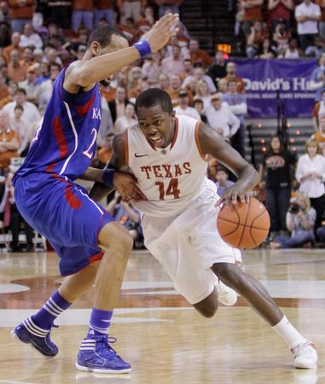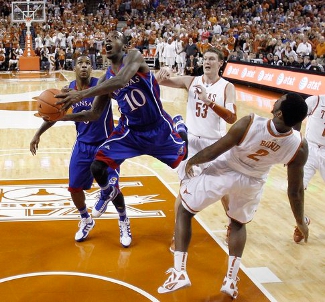Bridgestone Arena | Nashville, TN | Tip: 11:15 A.M. CT | TV: CBS LRT Consecutive Game #220 For the 14th-consecutive season, the Texas Longhorns are in the NCAA tournament. If you regularly read this website, you’re already quite familiar with that nugget of knowledge, and you also know that Texas is one of just six programs that own an active streak of at least that length. Hidden behind that gaudy number, however, is a series of disappointments. In those 13 previous visits to the NCAA tournament, the Longhorns have exceeded seed expectation just one time. In 2002, the 6th-seeded Longhorns were able to win two games in the NCAA tournament, knocking off 3-seed Mississippi State in front of a partisan crowd in Dallas to advance to the Sweet 16. Of those other 12 trips to the Big Dance, the Longhorns simply matched seed expectation six times, and fell short of seed expectations in six others. Seed expectation doesn’t even tell the whole story, as nine of the 13 trips to the NCAAs under Barnes ended with the Longhorns losing to a lower seed. While the Selection Committee doesn’t always get the seeding right, the overall trend is troubling. Under Barnes, it appears that the Longhorns can’t handle the pressure of being the favorite.
The Bearcats are playing their best basketball in March Fortunately, this year there are no expectations. With one of the 20 youngest teams in America, the Longhorns had to fight all season long just to get into the tournament. As a result, Texas enters the Big Dance as the lower seed in its opening game, a first in Barnes’ 14 years with the program. The Longhorns proved that they are a dangerous team in near-upsets of elite squads like Baylor, Kansas, and Missouri, but never logged a big win that would make them truly scary. Could this talented, inexperienced team be the one that finally gets the monkey off its coach’s back? If they are going to do so, the Longhorns will have to get through the 6th-seeded Cincinnati Bearcats. Known best for their brawl with intra-city rival Xavier, Mick Cronin’s team has quietly and steadily improved over the last two months. Last weekend, a big win over Syracuse in the Big East tournament semifinals captured the attention of the college basketball world and once again put the Bearcats firmly in the national spotlight. A loss to Louisville in an ugly championship game put an end to the movie-script tale, but it left the Bearcats with something to prove heading into the NCAAs. By the numbers When you look at these two teams on paper, the match-up becomes even more intriguing. Where Texas has a statistical strength, Cincinnati does as well. Where the Bearcat numbers are weaker, those of the Longhorns are, too. With two teams so perfectly aligned to neutralize the strengths of their opponents, this game will likely come down to who can actually execute when pushed out of their comfort zone. Despite having an offense that often stalls out, the Longhorns have been able to manufacture points by earning free throws. Texas is one of the best teams in the country at getting to the line, shooting more than two free throws for every five field goal attempts. On Friday, that could be much more difficult against a Bearcat D that hardly ever sends opponents to the charity stripe. Cincinnati allows just one free throw for every four field goal attempts, one of the ten best defensive FTR marks in the country. On the other end of the court, Texas has consistently sent its opponents to the stripe all season long. The Horns have a defensive free-throw rate just shy of 42%. Fortunately, the Bearcats are one of the 25 worst teams in D-I hoops when it comes to grinding out points at the line. With a team that makes just 64.1% of their free throws, that is probably a net positive for Coach Cronin. It’s also reassuring for the Horns, who will likely give the Bearcats many more attempts than they are used to. The one area where the teams’ strengths and weaknesses diverge is on the glass. Cincinnati and Texas are both fantastic on the offensive end, but horrible on the defensive boards. The Longhorns are ranked 15th in the nation in offensive rebounding according to Ken Pomeroy, snagging 38.4% of their missed shots. The Bearcats aren’t too far behind, grabbing 36% of their own misses. Defensively, both teams are ranked in the bottom 100 of Division I, with the Bearcats holding a slight edge. The winner of this game will likely be the one who finds greater success turning their numerous second chances into points. Meet the Bearcats Like Texas, Cincinnati has a very small rotation with a thin frontcourt. The team’s main presence in the paint is Yancy Gates (No. 34), who became a household name when he landed a sucker punch on the jaw of Xavier’s Kenny Frease. He was suspended six games for his role in the melee, but came back and produced workmanlike numbers in Big East play. A stout 6’9″, 260 pounds, the senior posted five double-doubles in twenty conference games and averaged more than nine boards in Big East contests. Thanks to Gates’ suspension, Cincinnati discovered a new offensive approach that worked wonders for the team. With just two other forwards left to play consistent minutes during the six-game suspension, Cronin and the ‘Cats went with a four-guard look. Floor spacing improved, driving lanes opened up, and the offense was immediately more efficient. Naysayers would point to the quality of opponents on the Cincinnati schedule in mid-Decembber, but the results were hard to argue with. In the first eight games of the season — a stretch which ended with the Xavier game — the Bearcats scored just 0.99 points per possession. In the eight games that followed — which included the team’s first three Big East contests — Cincinnati put in 1.17 points per possession, and did it without their senior big man. It wasn’t just the suspension of Gates that led to the new look for Cincinnati. Junior guard JaQuon Parker (No. 44) had missed the first seven games of the season and saw his first action in that infamous Xavier game. With Gates out of the lineup and sophomore Justin Jackson (No. 5) now the only starting forward, Parker was thrust into the starting five in only his second game of the season. Just 6’3″, Parker is a strong 210 pounds, and he brings some added toughness to a team that is rather undersized by Big East standards. He’s the team’s second best rebounder, snagging more than five per game, and he’s strong enough to finish through contact when he drives into traffic. Parker is solid going to his left and is able to find cracks in the defense off the bounce, an absolute must-have skill in the Cincy attack. Jackson, meanwhile, has become the team’s sixth man now that Gates is back in the starting five. He’s a long and lean 6’8″ guy with a face-up game and ridiculous athleticism. He has excellent speed in the open court, which opponents quickly realize when he swats away a fast break bucket from behind the play.
Sean Kilpatrick is a threat from long range One thing currently limiting Jackson’s game is his tendency to commit needless fouls. He actually averages 5.6 whistles per 40 minutes, and is the only Bearcat who has fouled out of more than two games this season. Of course, he’s all but guaranteed that title at the team banquet, as he’s already been DQ-ed six times this year. In the backcourt, you’ll find the only two Cincy players to start all 34 games this year, senior Dion Dixon (No. 3) and sophomore Sean Kilpatrick (No. 23). Dixon is yet another guard who can quickly drive the lane and finish at the rim, and the Bearcats find a ton of success by simply setting back picks for him on the perimeter. Kilpatrick can also penetrate and finish, but his biggest role on the team is knocking down triples. With Parker, Dixon, and point guard Cashmere Wright (No. 1) slicing up defenses on the drive, Kilpatrick can camp out on the arc for the kick-outs. His 228 long-range attempts are the most on the team by far, and his 6-of-9 performance behind the arc was key to upsetting Syracuse in the Big East tournament semis. That was the best three-point game in quite some time for Kilpatrick, who had gone more than a month since previously cracking the 33% barrier from behind the arc. At the point, Wright is key to making the four-out, one-in approach work. He can feel out defenses on the dribble, find the weak spots, and turn that into points or a well-timed assist. Wright has great body control inside to finish amidst the trees, but also does a great job slipping dump-offs to the big man on the block when the defense converges. His assist rate is just outside of the Top 100 nationally, as the junior logs a dime on nearly 30% of the buckets made when he’s on the court. Those six players eat up almost 84% of the team’s minutes, so the rest of the rotation sees very little action. Freshman guard Ge’Lawn Guyn (No. 14) and Senaglese big man Cheikh Mbodj (No. 13) both average about nine minutes per game. Guyn provides some backup minutes for Wright at the point, but had just five assists in his limited Big East action. Inside, Mbodj still looks like he lacks confidence at times, despite being an All-American at the junior college level Keys to the game It’s the biggest game of the year for the Longhorns, so we’re expanding from the typical trio of game keys to an entire list. Texas doesn’t need to do all of these things to win, but these are the most important things for the Horns to keep in mind when facing the Bearcats. 1) Deny dribble penetration – The Cincinnati offense is predicated on penetration from the guards, leading to layups at the rim, dump-offs to the bigs, or kick-outs for three. The Bearcats do not shoot very well from the field, with a two-point field-goal percentage that is in the bottom half of Division I hoops. Texas needs to close off the driving lanes and turn back the penetration, forcing Cincinnati to beat them with the jumper. 2) Rotate quickly in help situations – With a backcourt as quick and talented as Cincinnati’s, that goal of denying dribble penetration is easier said than done. There are going to be possessions where the Bearcat guards get past the Texas perimeter defense, and the rest of the Longhorns need to be ready to react. Cincinnati loves setting those back picks on the wings for their guards, so the help defense has to be there. Texas cannot afford to let Cincinnati drive unimpeded to the rim. 3) Limit second chances – If Texas can successfully force Cincinnati into taking jump shots, there will be quite a few misses clanging off the iron. Unfortunately for Texas, that can often work out even better for a Bearcat team that cleans up the offensive glass. The Horns are going to give up offensive boards, but need to limit second-chance points for Cincinnati. That means getting a body on Gates, Jackson, and Parker once the shot is up, and not allowing easy buckets in the scramble after long boards. 4) Make the misses count – As good as the Bearcats are at reclaiming missed shots, the Longhorns are even better. Cincinnati utilizes both man and zone defenses, but Texas should be able to do a solid job on the offensive glass against both looks. The Bearcats will have no specific box-out assignments in the zone, while Texas actually has a height advantage to exploit in man-to-man situations. The Longhorns are bound to reclaim a lot of their missed shots in this game, but they have to actually turn those into points. Fortunately, Texas did a great job of this against Missouri, so Horn fans are hoping that will carry over into this one.
Although rare, Cincinnati does occasionally turn it over 5) Stay aggressive against the zone – With Texas shooting poorly from outside this season, Cincinnati will probably stick with their zone for much of today’s ballgame. Unfortunately, the Horns have had some rough, futile stretches in games where they have faced that type of defense. During the painful sets, players stand around, cuts are lackadaisical, no one flashes to the middle, and guards don’t try to collapse the defense with penetration. When the Longhorns actually execute — like they did against Baylor in the first half of their game in Waco — the youngsters can easily slice up a zone. The rub is that they have to be willing to play intelligently and do all of those little things to score against Cincinnati today. 6) Shake things up – Cincinnati hardly ever turns the ball over, but when they do, it’s typically in the open court. DePaul and Marquette were both able to rattle the Bearcats in transition, and that led to easy points. Sometimes that was the result of poking the ball away in the open court, but often the miscues happened just because Cincy guards weren’t comfortable at that pace. The Bearcats are excellent at controlling the ball in their half-court sets, and are very tough to beat at their preferred tempo. Texas isn’t exactly a run-and-gun team, but the Horns might want to consider mixing in some pressure to force some mistakes and get a few easy points. |













